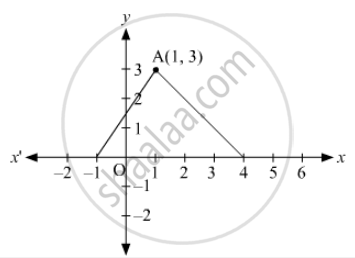Advertisements
Advertisements
Question
If A(3, y) is equidistant from points P(8, −3) and Q(7, 6), find the value of y and find the distance AQ.
Solution
It is given that A(3, y) is equidistant from points P(8, −3) and Q(7, 6).
∴ AP = AQ
Squaring on both sides, we get
\[25 + \left( y + 3 \right)^2 = 16 + \left( y - 6 \right)^2 \]
\[ \Rightarrow 25 + y^2 + 6y + 9 = 16 + y^2 - 12y + 36\]
\[ \Rightarrow 12y + 6y = 52 - 34\]
\[ \Rightarrow 18y = 18\]
\[ \Rightarrow y = 1\]
Thus, the value of y is 1.
APPEARS IN
RELATED QUESTIONS
The base PQ of two equilateral triangles PQR and PQR' with side 2a lies along y-axis such that the mid-point of PQ is at the origin. Find the coordinates of the vertices R and R' of the triangles.
In Fig. 14.36, a right triangle BOA is given C is the mid-point of the hypotenuse AB. Show that it is equidistant from the vertices O, A and B.

We have a right angled triangle,`triangle BOA` right angled at O. Co-ordinates are B (0,2b); A (2a, 0) and C (0, 0).
Name the quadrilateral formed, if any, by the following points, and given reasons for your answers:
A(4, 5) B(7, 6), C (4, 3), D(1, 2)
Find the equation of the perpendicular bisector of the line segment joining points (7, 1) and (3,5).
The line joining the points (2, 1) and (5, -8) is trisected at the points P and Q. If point P lies on the line 2x - y + k = 0. Find the value of k.
In what ratio does the point (−4, 6) divide the line segment joining the points A(−6, 10) and B(3,−8)?
Find the points on the x-axis, each of which is at a distance of 10 units from the point A(11, –8).
If the point A (4,3) and B ( x,5) lies on a circle with the centre o (2,3) . Find the value of x.
In what ratio does the point P(2,5) divide the join of A (8,2) and B(-6, 9)?
In what ratio does the line x - y - 2 = 0 divide the line segment joining the points A (3, 1) and B (8, 9)?
Find the value of a, so that the point ( 3,a ) lies on the line represented by 2x - 3y =5 .
If the vertices of a triangle are (1, −3), (4, p) and (−9, 7) and its area is 15 sq. units, find the value(s) of p.
If \[D\left( - \frac{1}{5}, \frac{5}{2} \right), E(7, 3) \text{ and } F\left( \frac{7}{2}, \frac{7}{2} \right)\] are the mid-points of sides of \[∆ ABC\] , find the area of \[∆ ABC\] .
If A (1, 2) B (4, 3) and C (6, 6) are the three vertices of a parallelogram ABCD, find the coordinates of fourth vertex D.
The distance of the point (4, 7) from the y-axis is
The coordinates of the circumcentre of the triangle formed by the points O (0, 0), A (a, 0 and B (0, b) are
The coordinates of the fourth vertex of the rectangle formed by the points (0, 0), (2, 0), (0, 3) are
In Fig. 14.46, the area of ΔABC (in square units) is

If P(2, 4), Q(0, 3), R(3, 6) and S(5, y) are the vertices of a parallelogram PQRS, then the value of y is
If the coordinate of point A on the number line is –1 and that of point B is 6, then find d(A, B).
